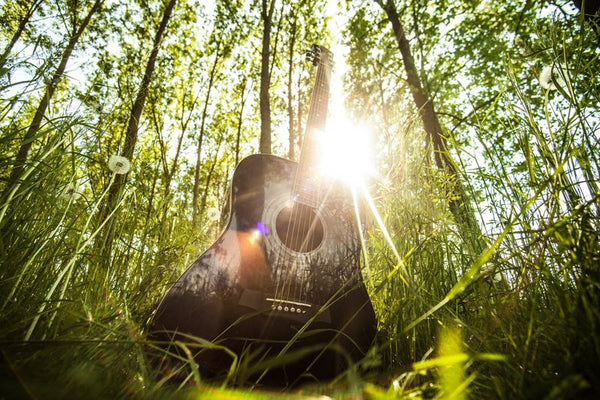Guitar Humidification and Humidifiers – Managing Moisture
Guitars need the right humidity but maybe you aren’t sure on the details. In this article we’ll clear away the fog with everything you need to know about proper humidity your guitar. Watch our video or read on for more info!
Humidity is nothing more than the amount of water contained in air. Humidity varies wildly throughout the day, with higher humidity at night because air heats up and dries out some during warmer times of day, and as it cools the amount of water in the air increases. This variance is called relative humidity. But that’s outside. We’re concerned with indoor humidity, which can be very different. Why do I mention this? Because you shouldn’t go only by the weather forecast. Humidity can be affected by running the heat, A/C, or in a room that gets lots of sun. For guitars, humidity should be 40%+.

Ideally 40-70% is the accepted range most agree on. Levels below this can cause string buzzing; with prolonged low humidity causing things like soundboard cracks, warping, neck shrinkage - all with expensive and irreversible outcomes. An ounce of prevention is worth a pound of cure, right? In this case, a free ounce of water!
3 Humidifying Methods - the Sound Hole and Beyond
There are 3 main ways to humidify your guitar collection, aside from using a room or house humidifier.
The first is the guitar soundhole humidifier. It’s a simple plastic device with vents and a sponge, moistened with the supplied solution (usually alcohol and water mixture) and then inserted in the guitar soundhole. Many of these devices attach to the strings so they hang over the soundhole and inside the acoustic guitar body. Since the body of an acoustic guitar is unfinished inside (no varnish or clearcoat), that means it’s exposed wood which will give off and take in moisture. Believe it or not, the soundboard of an acoustic or classical guitar can absorb and release a whole ounce of water. As we said, think of it as an ounce of prevention!
The second method is a simple wet towel, this works in a pinch or if you’re traveling away from home and need a quick blast of humidity to fight a dry climate or get rid of some pesky, dry-induced string buzzing. Just wet an entire hand towel, wring out the dripping excess, and wedge it between the strings and soundhole. Microfiber towels absorb lots of water, so those are a good choice. Do your best to seal off the soundhole so the moisture gets trapped inside the body of the guitar. If your guitar is not high gloss (rare), avoid this method as wood with no protective clearcoat may stain from a wet towel. Be careful not to let it drip in the soundhole on your manufacturer label.
The final and most comprehensive method is the full case humidifier, by Humicase. This is a premium hardshell case with two humidity pods built in to the upper lid. It's a full-size humidor for your guitar. The pods are removable. Charge them up with solution, then install them in the case and shut your guitar in the case. The pods create a nice very humid environment inside the case, you’ll almost hear your guitar’s muffled ‘Thank You!’s’ from inside as it basks in the tropical, sultry environment. (If it starts asking for a pina colada and some suntan lotion, you’ll know it’s reached a vacation-like state.) 
The huge bonus with the Humicase system is it creates a ‘whole-guitar’ climate controlled environment, including the neck. Soundhole humidifiers do nothing for the neck. Since most humidity issues happen with the guitar body, neck humidification is less common but it is the best all around game-plan in dry climates (as mentioned in our video, necks can be damaged from low humidity but it's rarer, and usually extreme heat is a component of neck damage). A Humicase takes the place of a whole room humidifier for your guitar. One important note – don’t attempt to travel or transport the guitar with the little pods in place. They only attached by Velcro, and can come loose. An impact to your guitar’s body and you’ve got a permanent ding; now humidity is less of a problem! Take them off and put them in the case compartment while enroute.
Humidity Analysis at Home, Plus Tips
That covers humidity for your guitar, so here’s a few things to know at home. The first thing is to get a digital hygrometer (humidity sensor). These are cheap and nowadays come contained in little home weather stations that take temperature, humidity and make for a nice desktop accessory. Measure the humidity in a few different rooms and select a room with the highest reading. Often this is a room with an attached bathroom or water source, as these tend to boost the area humidity a bit. The target is at least 40% relative humidity to keep your guitar in the safe zone. Get under that level, and expect buzzing and issues. Lower than 20 or 30% and you’re in danger of prolonged exposure including body cracks and other fun stuff. 
We’ve already mentioned how certain rooms vary in humidity, this is usually due to location. Is your room in the front of the house getting more natural sun exposure? More windows, more heat or A/C in that room? Is there a shower or sink nearby that gets plenty of use? All of this can affect a room’s humidity. Your weather station or digital hygrometer will let you know which area of your house is best. In some cases, no humidity treatment is necessary. If you live near the beach chances are you won’t ever have to worry about low humidity. If you live near a desert-region, you do need to monitor humidity!
Our last tip on humidity is house plants. Plants increase humidity in a room! Especially large ones with huge pots. If the plant requires regular watering, a lot of that water goes up the stalk and out the leaves, as well as evaporating from the pot. That’s good news for your guitars. While plants alone won’t combat a tough humidity situation, they will give it a boost and along with selecting the right room in the house may be all you need to stay above 40%. Otherwise just supplement your plan with a humidity device.
Finally, more is usually better with humidity and guitars. However if you live in an extremely humid or tropical environment, such as the Florida Keys, be aware that ongoing extreme humidity can do things like loosen up body glue joints and affect guitar finishes. A dehumidifier isn’t a bad idea in climates of extreme humidity. At least you’ll never have to worry about body cracks, those are usually from extreme dryness.
So that’s it, everything you needed to know about humidity! Looking for another way to keep your guitars at their best? Check out the Guitar Scratch Remover polish kits below, great for regular polish and upkeep and for removing those pesky scratches. Thanks for reading!
